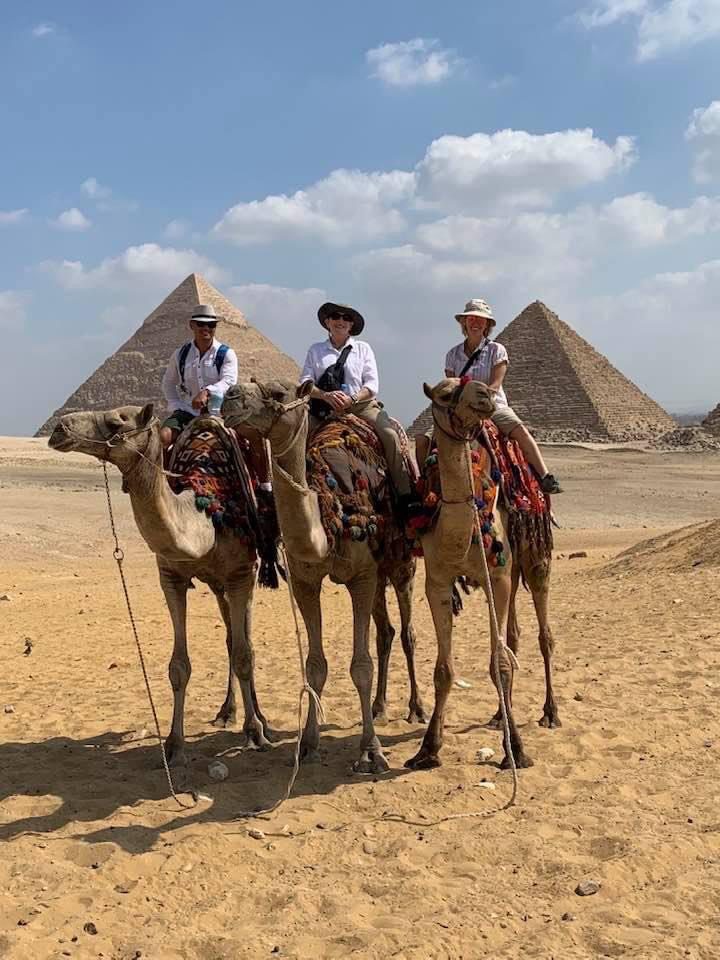We recently went on a journey to the pyramids and beyond, experiencing Cairo’s enchanting embrace! This was a trip of a lifetime for sure. Vuong found this 9-day tour on Left Lane Sports during COVID and got a screaming deal. He paid $1000 each for this all-inclusive, small group tour. Unfortunately, Left Lane Sports no longer sells travel packages. However, the outfitter was actually “Encounters Travel,” and the tour was called “Nubian Adventure.” You can book it now for only $1600 per person, which is still a great deal for everything we received!
There are other tour options which include trips to Hurghada and the Red Sea, the Dead Sea, etc. Browse their website to see which tour suits you best!
See photos from our trip here.
Itinerary
We spent time in Morocco before this tour, during which we trekked through the High Atlas Mountains, climbed Jebel Toubkal, and visited Marrakech, Essaouira, Zagora, and several other significant sites. Read about the Morocco portion of our trip here, here, and here.
DAY 1: Arrive into Cairo, transfer to hotel
DAY 2: Cairo, Pyramids, Sphinx & Museum tour
DAY 3: Arrive in Aswan, Nubian Village, Philae Temple
DAY 4: Aswan, Abu Simbel option, Felucca Nile River cruise
DAY 5: Felucca, Edfu, Luxor temple
DAY 6: Luxor, West Bank tour, free time
DAY 7: Luxor, Karnak temple
DAY 8: Cairo, optional tours, back streets of the Khan-el-Khalili bazaar
DAY 9: Cairo, departure transfer to the airport

Cairo
We arrived into Cairo Airport (CAI) around midnight. Our driver was waiting for us and took us to our hotel, The Cairo Pyramids Hotel. Our room was nice, and we could actually see the silhouette of the pyramids from our balcony!
Cairo is nuts. Traffic is ridiculous and there are so many people. The city is expansive! It can be overwhelming. I recommend reading about the history, politics, religion, and customs, but don’t get too bogged down in details. Like any major city, there are safer areas and other areas best avoided, particularly as a solo female traveler. Just be smart, be aware of your surroundings, dress modestly, keep your crossbody bag in front secured under a hand, and go.
I’m going to go ahead and tell you about our time in Cairo. We spent a night here before the bulk of our tour, then came back for two nights at the end, but it makes more since to give you all the info about Cairo in one place. Then, I’ll follow up with two more posts about the rest of our time in Egypt!
Pyramids of Giza
We had checked into our hotel after midnight and got about 4 hours of sleep. We met my dear friend, fellow GI Pathologist, and travel buddy Sara, and our guides Aboudy (pronounced Ah-booty) and Soul, in the lobby of the Cairo Pyramids hotel for a pre-tour briefing. Aboudy is a wonderful guide and human being! He is a certified Egyptologist and is extremely knowledgeable on this topic, his life’s passion. If you are interested in booking a tour with him, let me know!
Even if you don’t use Aboudy, be sure your guide is a certified Egyptologist. Having an in-depth knowledge of this ancient culture is essential to showing you the sites.
We hit the pyramids first thing! We timed this perfectly- we went first thing in the morning, before the heat and the crowds. AND, this was late 2021, so COVID was still in full swing. We still used our masks inside, on planes, and in crowded places, but it was totally worth it. Obtaining COVID tests before leaving each country was a bit of a pain, but again- worth it to avoid the crowds. Fortunately, the pandemic has passed. Unfortunately, this means you won’t be quite so lucky as we were to avoid crowds.
The prevailing advice is to arrive early, even in normal times.
Nothing had prepared us for the scale of these feats of human engineering and creativity. The pyramids are massive! It boggles the mind to think of how ancient Egyptians built these marvels. A detailed description of how historians think this happened is beyond the scope of my little blog post, but you can geek out about it here. With that said, we all know the true builders of the pyramids… ancient aliens!
The pyramids are burial tombs, and the largest was built for the pharoah Khufu, and the smaller ones for his children and wives. You can go inside, but we opted not to. According to our amazing Egyptologist guide, Aboudy, there were other pyramids that were more interesting inside, where you could see more. So, we held out for those.
We took the obligatory camel and forced perspective photos, checked out the sphinx, and headed to lunch at Koshari Abou Tarek (see above). After lunch, we visited the Egyptian museum for the rest of the day, then boarded the overnight train to Aswan!
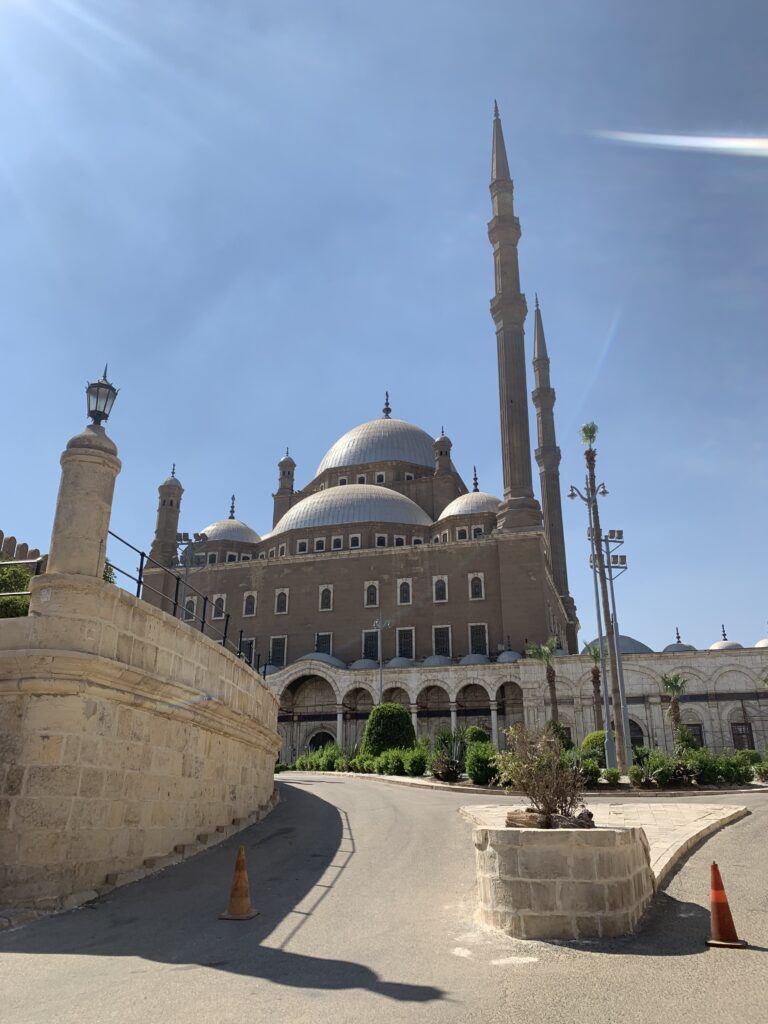

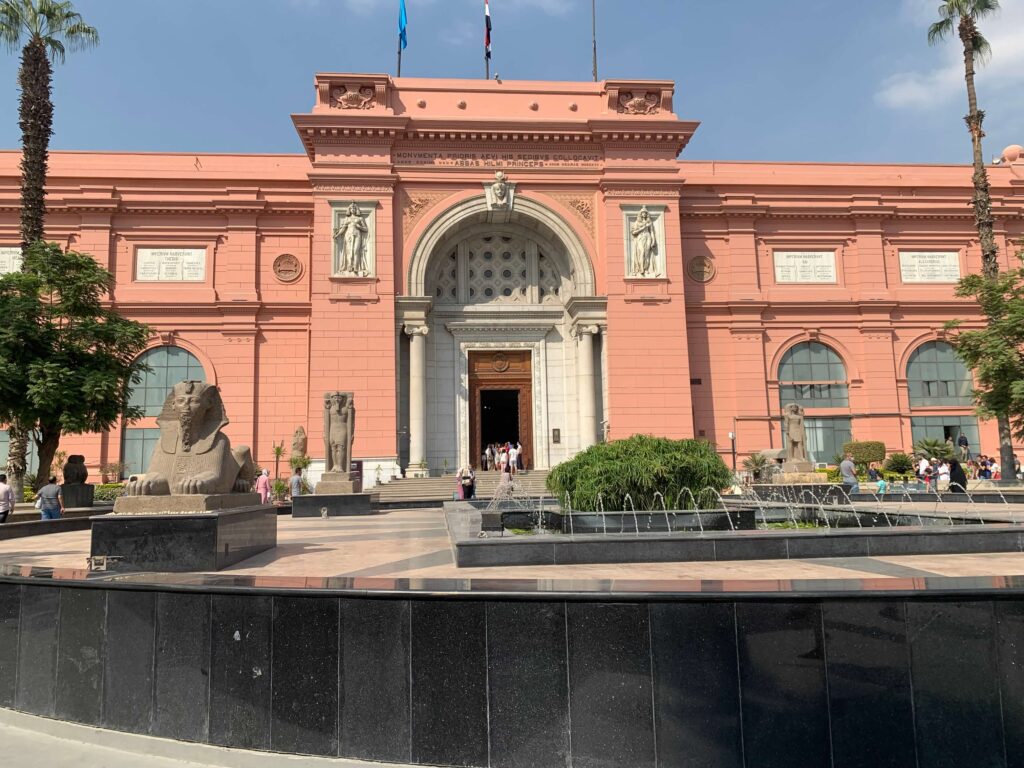

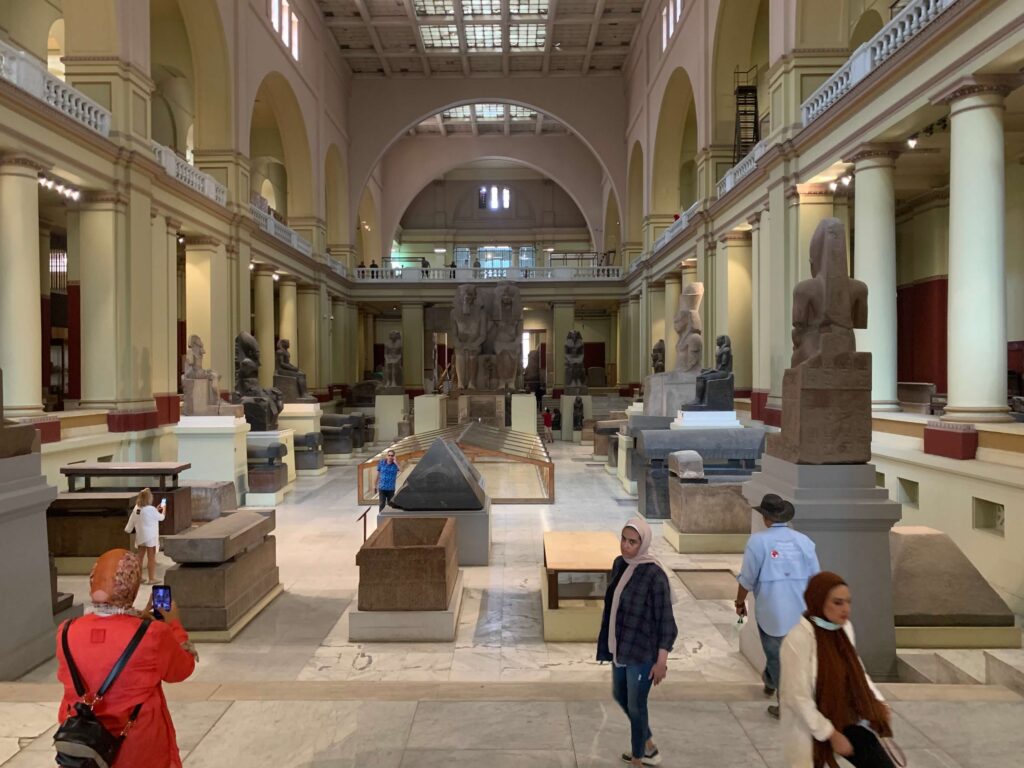

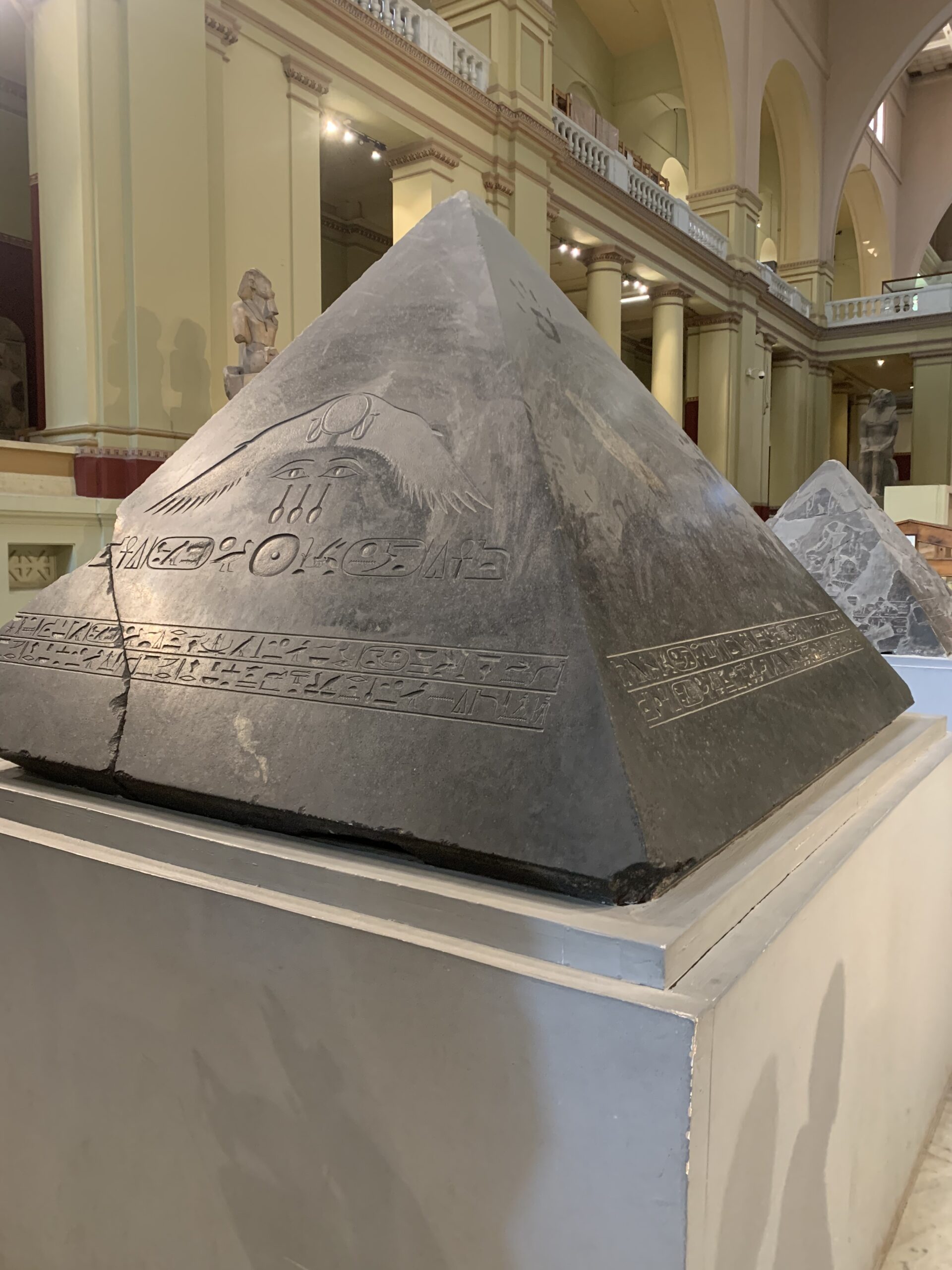

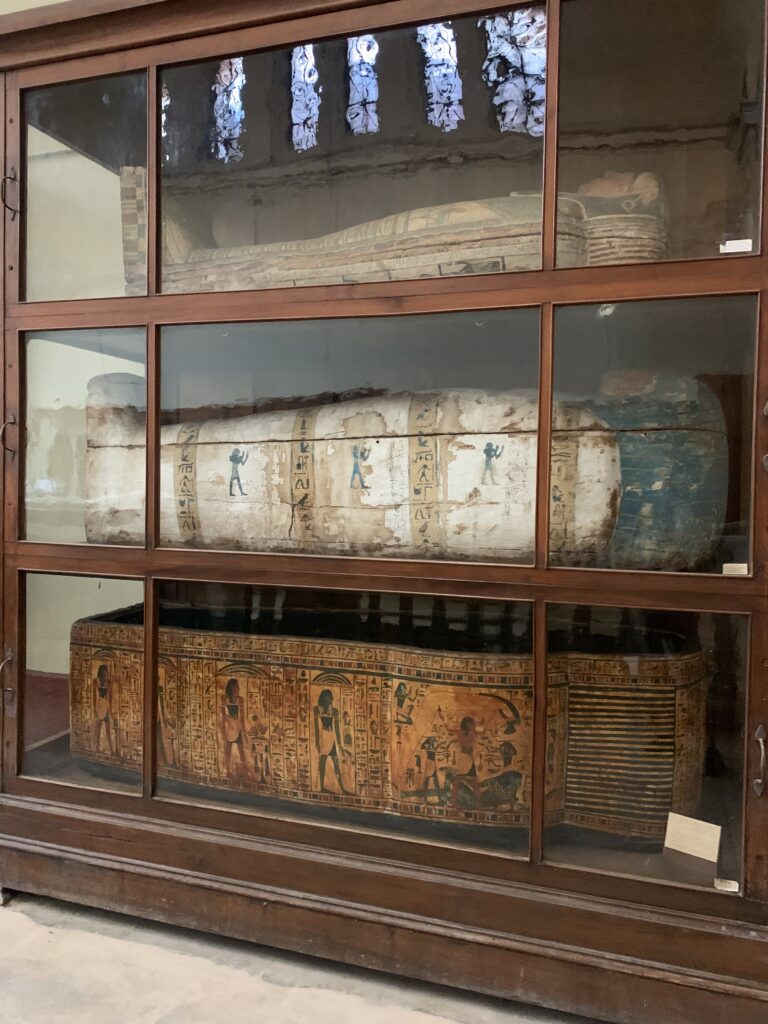

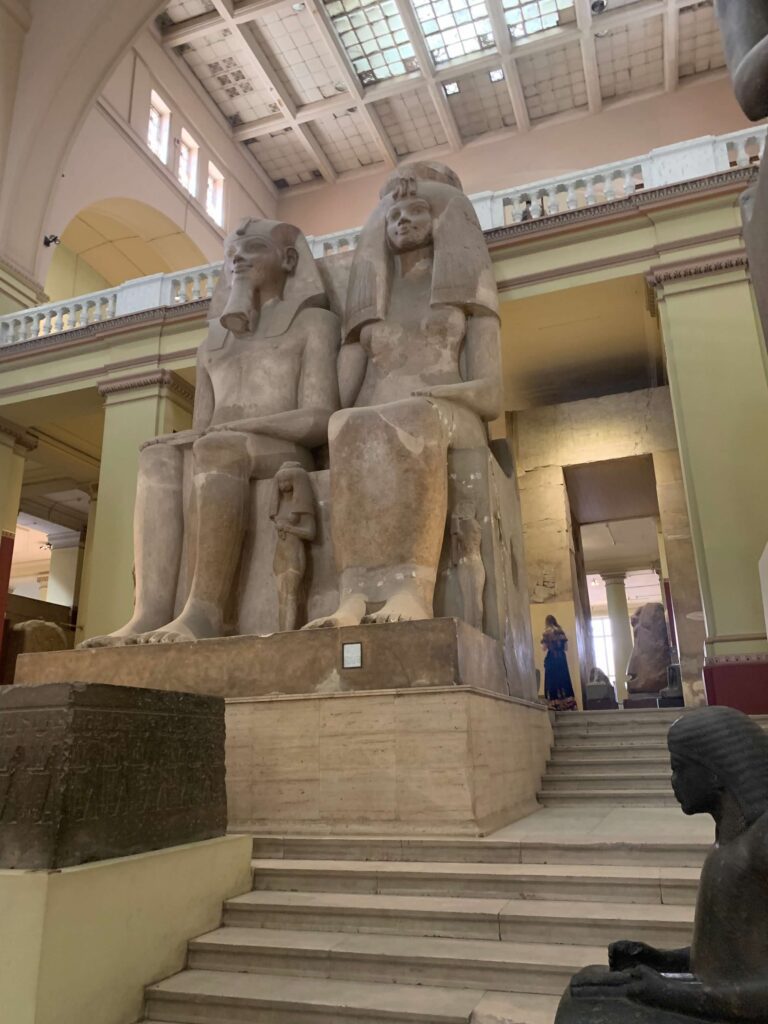



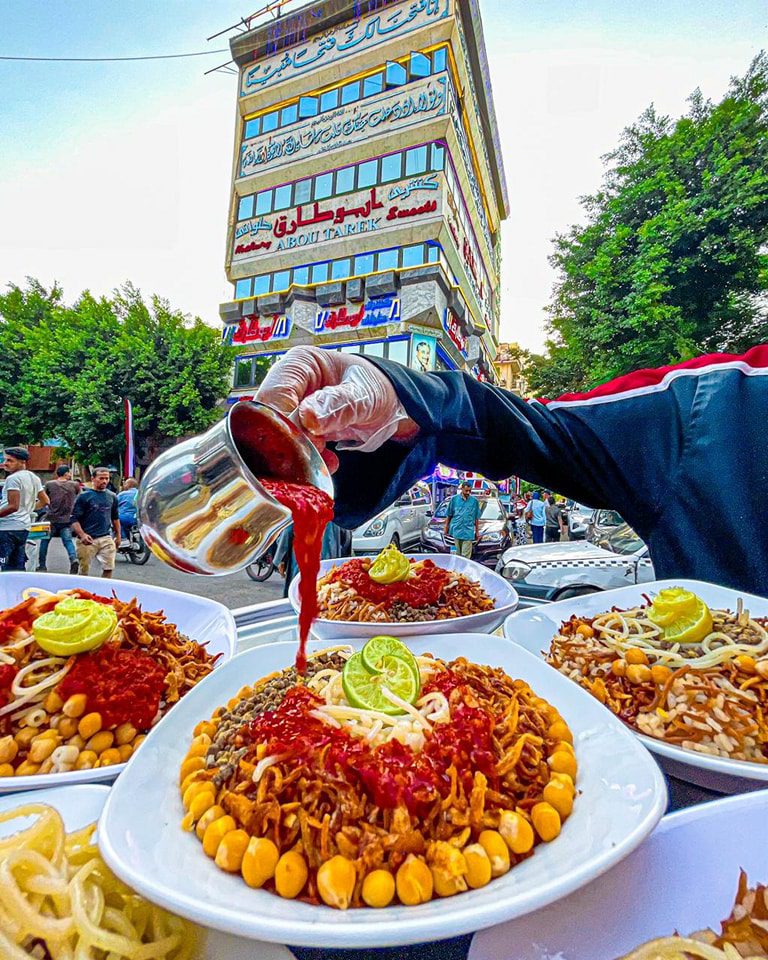

Getting Around Cairo
The metro is a great way to get around Cairo! There are buses and water buses, as well as taxis and private drivers. Read about how to navigate this mammoth city here.
What to eat in Cairo
Summarizing the best restaurants in Cairo is impossible. This city of 10 million people is humongous. It is expansive and has so many different neighborhoods. Suggesting you try to find a particular restaurant, when you may not even be staying in the same neighborhood, would be a fool’s endeavor. Explore on your own. Ask locals, your guide, your hotel concierge, yelp, or try places that look interesting. So, I’ll tell you where we ate and suggest a few dishes to try, and leave you to it! This just scratches the surface of Egyptian cuisine!
Koshari
I will mention one particular restaurant. Koshari Abou Tarek is arguably the best place to sample the unofficial Egyptian national dish. They proudly proclaim that there are no branches, and Koshari is the only dish they serve. Koshari contains rice, macaroni noodles, vermicelli, chickpeas, tomato sauce, fried crunchy onions, and various condiments to your taste. The overall vibe was of Egyptian spaghetti, and it was pretty yummy!
Street Food
Falafel, kebabs, kofta, and shawarma are common dishes eaten here, and are easy to find at street stalls and at restaurants. We had shawarma at Al Agha.
Naguib Mahfouz Cafe
Lunch at the Naguib Mahfouz Cafe was a special treat, and if you are wandering around the Khan el Khalili bazaar (which I highly recommend), you might consider dining here. Yes, it is touristy, but it is good! The only Egyptian who has won a Nobel Prize for Literature, Naguib Mahfouz, used to frequent this cafe and it was renamed in his honor in 1989. It is now managed by Oberoi hotels. The atmosphere is lively and the waitstaff dressed in tarboosh hats and full livery!
The AC felt wonderful, and we paid a guy to clean our shoes while we ate. We had Hawawshi, which is sort of like an Egyptian hamburger had a love child with a deep fried taco. If you don’t try this here, try it somewhere!
Dessert
Egyptian desserts are to die for!! Kunafa al-Khan resembles a bird’s nest and is absolutely divine! It is sweet and salty, soft and crunchy, warm and cool… everything! Baklava is amazing, with phylo dough, honey, pistachios… Pair your dessert with a strong cup of Arabic or Turkish coffee!
Where to stay in Cairo
The pyramids are just outside of the main part of Cairo, across the river from the city. For your visit to the pyramids, The Cairo Pyramids Hotel is tough to beat! It is luxurious and close to the pyramids, in the Haram neighborhood. It is also very close to the site of the new Grand Egyptian Museum, set to open in February of 2024. If you are a Marriott loyalist, check out the Le Meridien Pyramids. If you are a Hyatt loyalist (World of Hyatt points are currently the highest value, most sought-after hotel points), The Hyatt Regency Cairo West is your best bet. With that said, this is not the best neighborhood to make your base of operations, as there isn’t much else to do here.
For the rest of your time in Cairo, I’d recommend sticking around the city’s main tourist attractions. Downtown Cairo is a great place to get a feel for the city if you’re a first-time visitor. We stayed at the Sheraton Cairo, which was really nice, on the banks of the Nile, and right in the heart of things. Traffic in Cairo is a nightmare, so it’s best to stay within walking distance of the sites whenever possible. Sites in this part of town include the Egyptian Museum, Coptic Cairo (which is home to the “upside-down church), and Khan el Khalili. The latter is an expansive market full of souks and hawkers, and is a must-visit, in my opinion.
If you are a solo traveler or a couple/group who likes to be close to bars, restaurants, and shops, Zamalek, Maadi, or Garden City may suit you best. Zamalek has great nighlife, Maadi is a greener, more quiet area, and Garden City has luxe hotels with views of the Nile.
For a full description of the neighborhoods, including where NOT to stay, check out this article.
Sites to see in Cairo
The Egyptian Museum
The Egyptian Museum is an absolute must-see while in Cairo. Many artifacts from the pyramids and other significant sites in Egypt are kept here, and you can learn so much about Egyptian history on a visit. When we visited, the new museum was not yet open, but it is going to be spectacular. We were lucky to visit the museum while King Tutankhamen himself was in residence, along with his personal effects, pets, and family! No photos in that room…
Tahrir Square
You will read about Tahrir Square in almost any article about visiting Cairo. Rather that a bustling market or shopping area, this is a traffic circle… so only a drive-by is warranted. It is significant because numerous protests and demonstrations have occurred here, many of which sparked revolutions. Also, the current Egyptian Museum is close by.
Coptic Cairo
Coptic Christians are simply Christians from Egypt. They follow Jesus and number anywhere from 10 to 60 million. Coptic Cairo is in old Cairo, and to visit one should dress modestly, covering the knees, shoulders, and everything in between. If you are taking the metro, get off at the Mar Girgis station.
Coptic Cairo is home to the Hanging Church, so-called because it was built on top of the ruins of a Roman fortress, and when you are inside it kinda feels like an upturned boat or ship (an ark, if you will). It is actually Saint Virgin Mary’s Coptic Orthodox Church.
There are several other churches, the city’s first Mosque, and a Jewish Synagogue. The latter is thought to have been built at the site where baby Moses was found on the banks of the Nile!
We found this area to be cool, hip, and funky, with art museums and galleries, artisans, and cute cafes. Don’t miss it!
Khan el Khalili
Spend a half a day or at least a few hours here! This bazaar/souq is a massive labyrinth of hawker stalls selling souvenirs, crafts, clothing, jewelry, etc. There are numerous food stalls, cafes, and shisha houses. An entire area is dedicated to gold! We had ice cream and pomegranate as we explored this bustling area. Bring cash, prepare to haggle, and watch out for pickpockets. It is chaotic and crazy, but so fun!
The Citadel of Salah al-Din
This ancient fortification comprises several mosques, including the Alabaster Mosque, and a military garrison. It has amazing views of the city!
The Alabaster Mosque of Muhammad Ali
Not THAT Muhammad Ali! THIS Muhammad Ali was an Ottoman Albanian ruler who is considered to be the founder of modern Cairo. Read all about him on Wikipedia if you are so inclined!
You may have seen the minarets of this Mosque in photos of Cairo- it sits high above the city and has commanding views of the metropolis. It is one of the few mosques that can be visited by non-Muslims, so we had to go inside! I highly recommend that you do too.
Again, COVER YOURSELF! You’ll have to remove your shoes, so wear clean hole-less socks! Our guide, Aboudy, took us into this beautiful mosque and we sat criss-cross applesauce in a circle on the prayer rugs. He told us about the 5 pillars of Islam, which I had heard before but its always good to hear things again… my memory is not what it used to be! The 5 pillars of Islam are: visit Mecca, pray 5 times a day, fast during Ramadan, and give alms to the poor. The tenets of this religion are good and honorable, just like Christianity. And, just like Christianity, most followers are good people who want the best for themselves, their families, their homes, and everyone else.
Radicals are radicals, lunatics are lunatics, and good people are good people. People use (all) religions to justify their actions, but religious teachings do not justify the awful things people do to each other. That stuff comes from man, not God.
The more we travel, the more we see that people are just people. We all want the same things. To be happy, healthy, peaceful, prosperous, and to love each other.
Let’s celebrate our differences and remember our commonalities! We are not our religion. We are not our government!
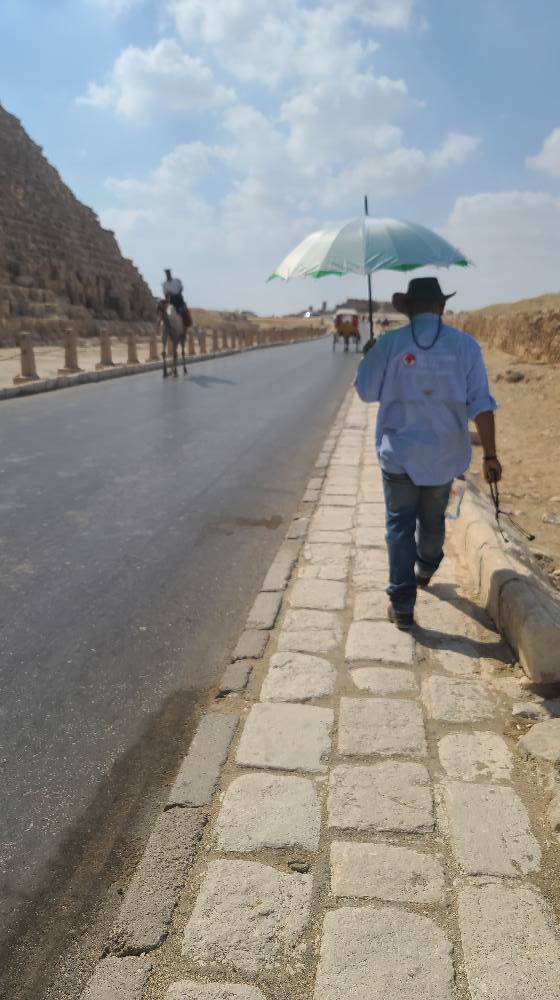

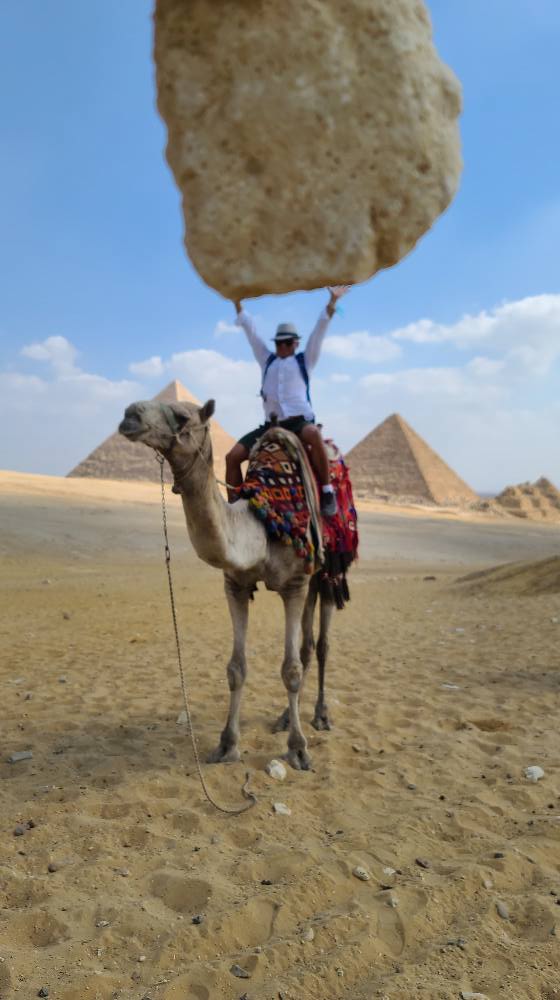

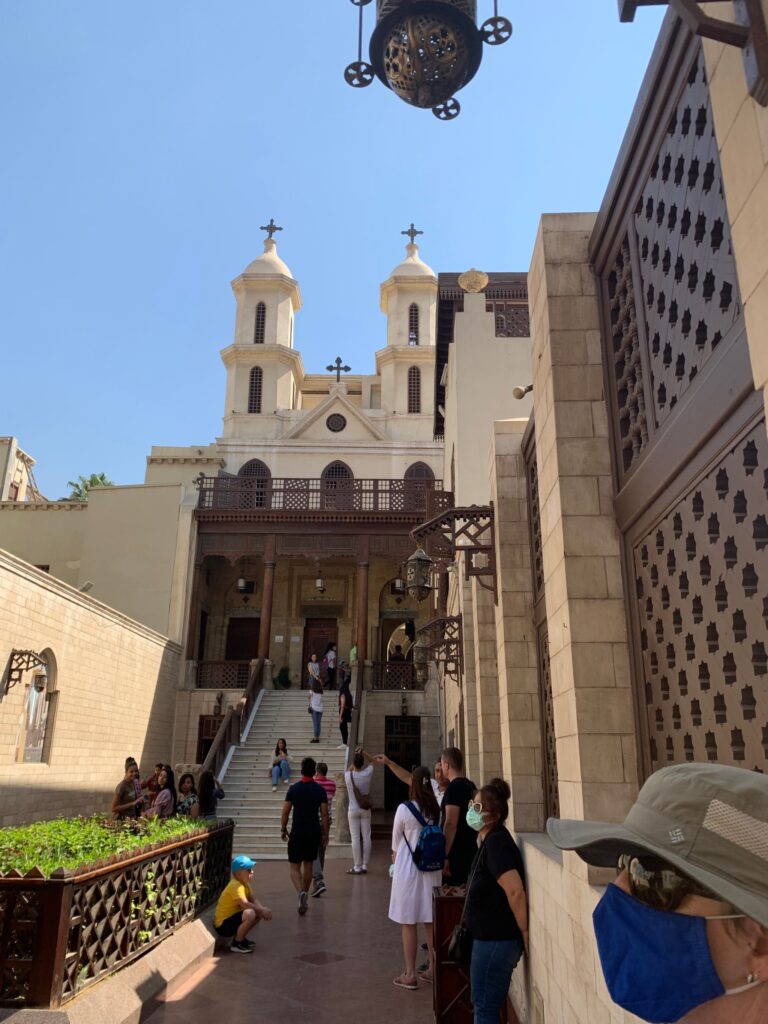

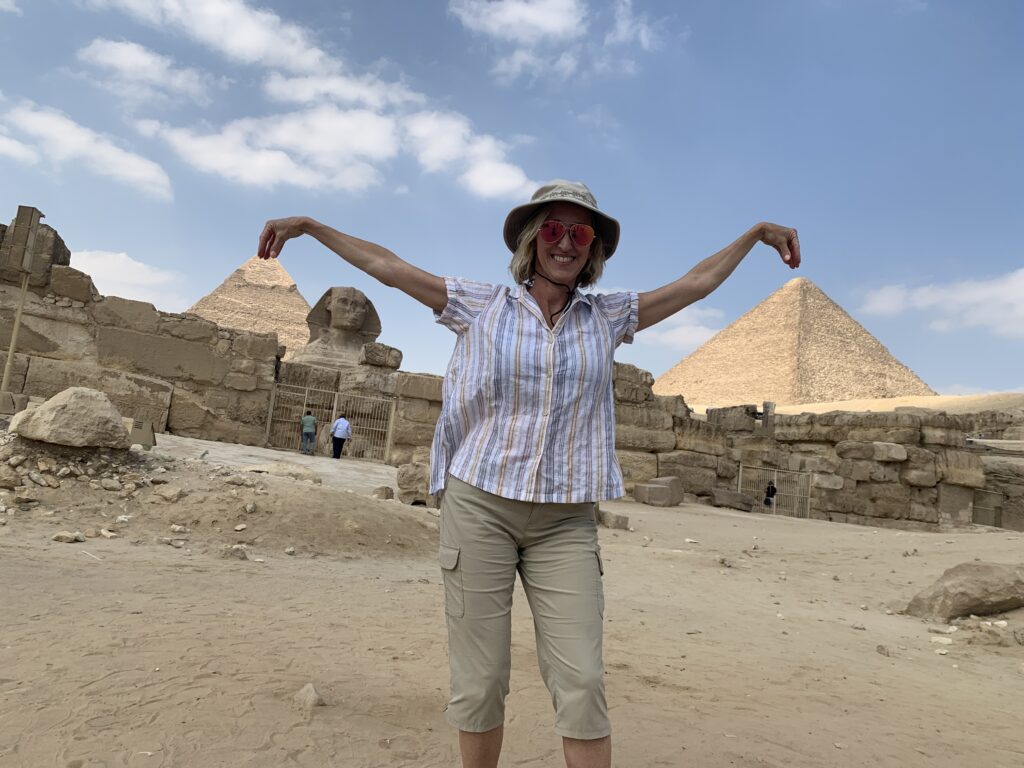



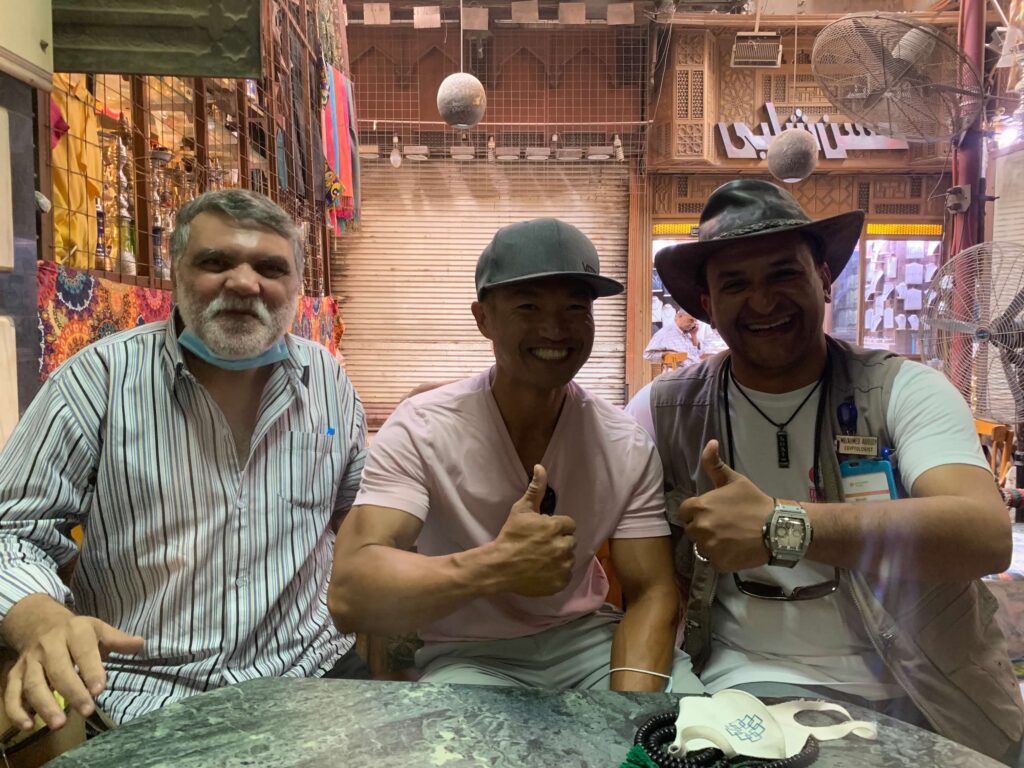

That’s all for now!
Come back next time to read about our time in Aswan, our visit to a Nubian Village, Felucca cruise on the Nile, and our time at Abu Simbel!

